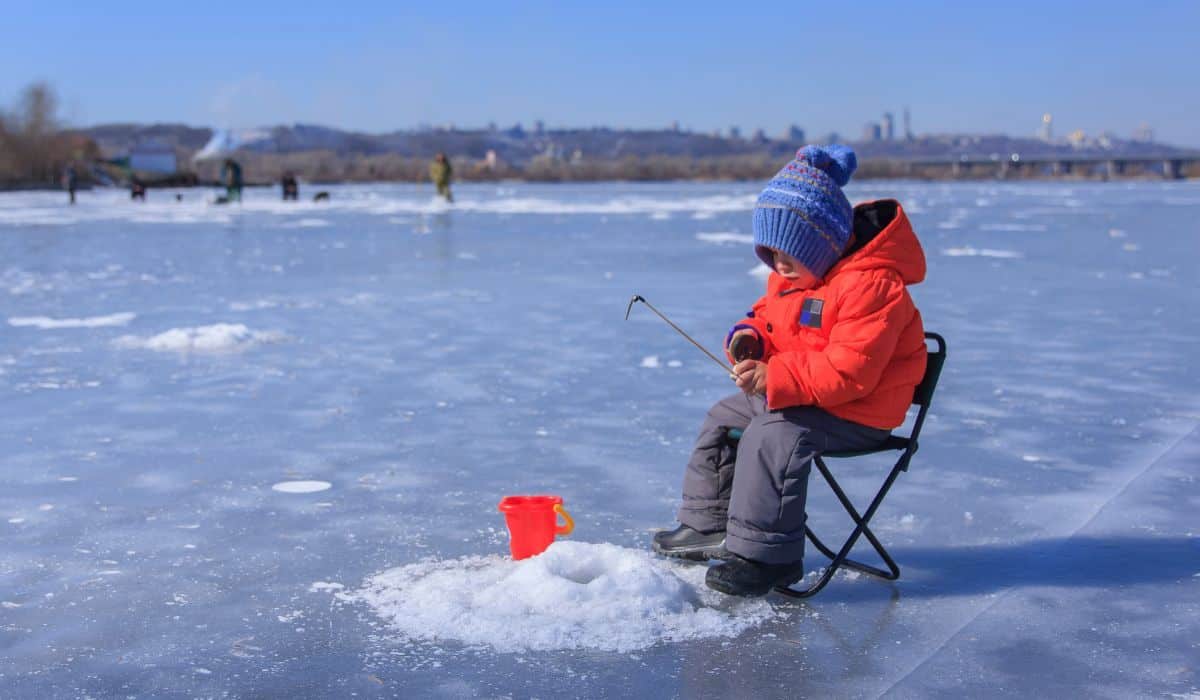For the keen angler, ice fishing is about the most fun you can have at subzero temperatures! It is an authentic, intrepid adventure, and the fishing is great too.
Perhaps you feel cold enough when you hit the local lake in your Jon boat, but believe us, it can get colder!
In this comprehensive guide, we will tell you everything you need to know to make a success, a hobby that is enjoyed across the world.
Pack your rods, a tent, and some great company as we explore this wintertime hobby, learning to stay safe as you go.
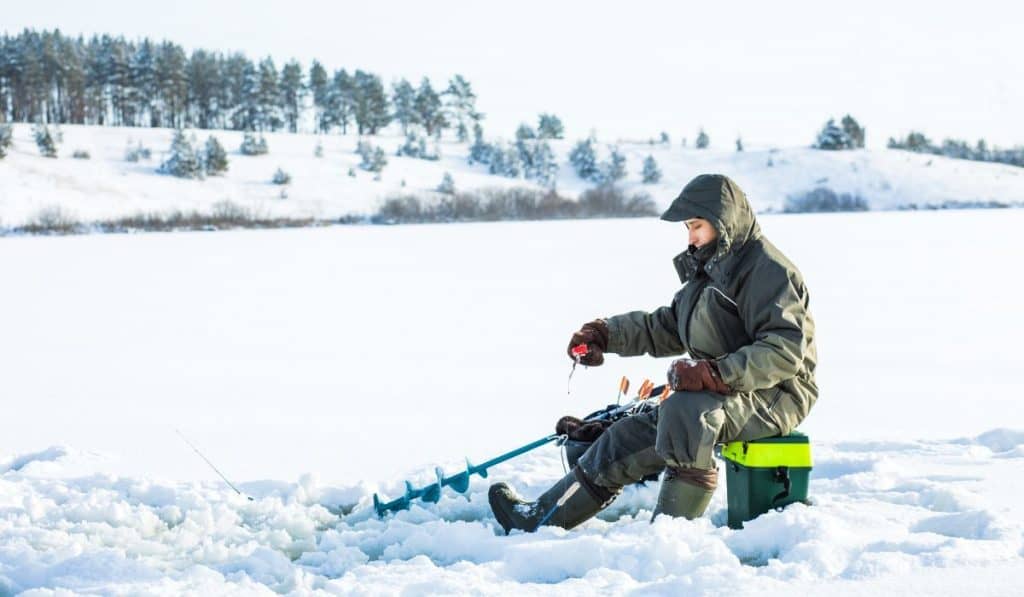
So, just what exactly is ice fishing?
Ice fishing is a fishing hobby that involves catching fish on frozen lakes and other bodies of water. The fish are accessed by drilling a hole in the ice to allow the fish to be hooked with a line, speared, or even clubbed.
To catch your fish, you will have to brace yourself for venturing out onto the frozen surface of the water. This is not for the fainthearted and requires discernment of the right type of ice that can take the weight of you and your gear.
Though ice fishing is now enjoyed as a recreation rather than a necessity, the catching of fish via a hole in the ice or hardwater angling has been the preserve of many indigenous and first nations peoples across the world.
Most noted historically, and admired, are the ice angling skills of the native peoples of North America whose oral and cultural traditions have handed down expertise in spearing fish out on the ice, which was observed and later adopted by the European settlers.
In Canada, the traditional skill of ice fishing is still being actively passed on to younger generations as a way of enjoying the environment and living off the land.
Europe also has a tradition of ice fishing, particularly in central and Eastern European countries known for their monastic aquaculture.
Daring poachers were known to fish through the ice of their expansive fishponds.
Ice fishing is also known in the icy reaches of Scandanavia and Iceland, which offer a good season with suitably frozen waterways.
5 great reasons why ice fishing is a great hobby!
If you ask an ice fishing addict, we’re sure that they will have many more, but here are 5 key benefits of getting out on the ice and landing yourself some very fresh fish!
1. Your ice fishing hobby is a great winter pastime!
If you love getting out on the water to fish on long spring and summer days, but find your season curtailed once the chill of winter sets in, you can take things to the opposite extreme and hit the ice.
With ice fishing, you can fish all year round! The colder it gets, the safer the ice is and the better the fishing.
Once you know how to handle yourself and keep warm on the ice, you will find ice fishing just as enjoyable as other kinds of angling.
2. With ice fishing, the good bites come to you.
Ice fishing is a satisfying endeavor as you almost always come away with a catch. If you think about it, the fish are going to be much easier to catch. During their grueling winter months, food is scarce so your bait will be incredibly popular with fish.
Your second advantage with ice fishing is that the low temperatures make the fish incredibly sluggish and those reflexes that would have gotten them off the hook simply aren’t there. This makes ice fishing a great experience for novice anglers who are up for braving the frost.
3. With ice fishing, you’ll have a great sense of adventure!
We can’t all go on an expedition to the north pole, but with ice fishing, you will feel like you are an arctic explorer, especially if there is a major wind chill.
One of the reasons so many anglers enjoy ice fishing is the sense of adventure that comes with being out on the ice.
With ice fishing, you have plenty of substrate for making some great memories. The bleak white expanse coupled with the dimness of the shelter makes this type of fishing truly unique.
As you drill down with your ice auger into the ice you will be tapping into your inner survivalist too.
4. For the enthusiast, ice fishing is an event with a great atmosphere!
Despite the harsh environment, you will struggle to ice fish alone. A suitably frozen lake is going to get a lot of action from fellow anglers looking for some good fishing.
In areas where ice fishing is popular you will find that many families gather to enjoy fishing together. So, you’ll have to learn to share all that good fishing.
5. You may enjoy ice fishing so much that you will travel for it.
For many anglers the call of the ice is irresistible, and they are willing to put in the air miles for prime ice fishing opportunities throughout the year.
Pack your rod as ice fishing is a great way to see the world!
Ice fishing holidays can take you to some of the most spectacular natural settings on earth, with guided ice fishing tours in Lapland, or amidst the Scandinavian northern lights.
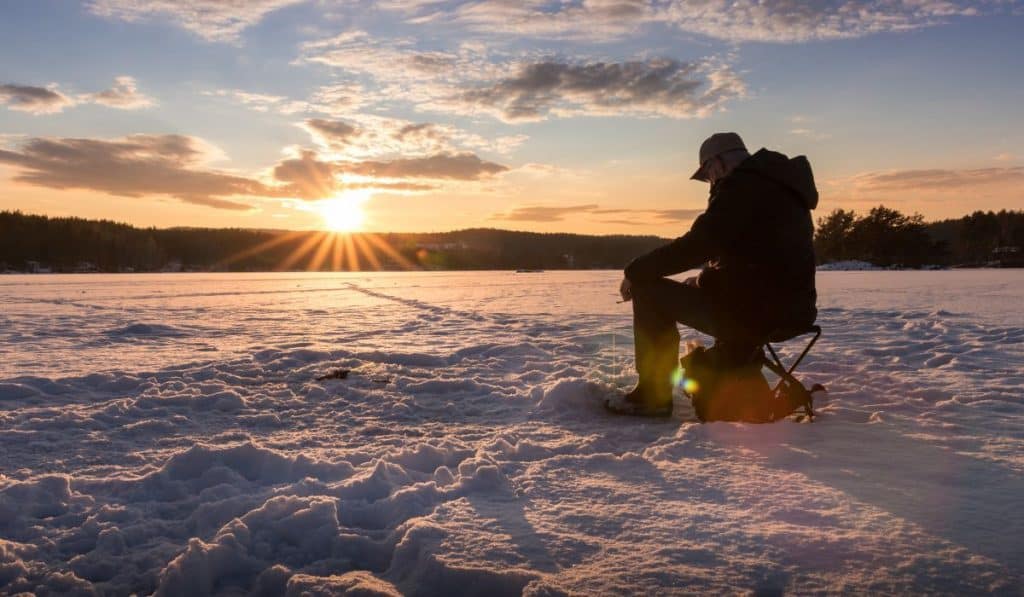
What does ice fishing involve?
Heading out onto open ice and trusting it with your body weight goes against just about every instinct, but this is where the pastime begins and ends.
Double up on base layers and well upholstered outer garments and trek or sled out to your frozen lake or river.
Once an assessment of the ice has been made (more on this below), snow can be cleared from your selected location and holes can be made in the ice.
This can be done with an ice saw, auger, or chisel. The hole should be no more than 10 inches (25 centimeters). Too large and someone risks falling through, too small and you can’t pull your fish through it.
An ice skimmer and sometimes heaters are used to keep the hole open. Time and experience will refine your technique and when leaving a hole, mark it in some way so that other anglers can stay safe!
You have several options for your angling technique while ice fishing:
- Light-rod fishing is similar to conventional angling and uses a small lightweight rod. Specialist ice fishing rods can be purchased, but a lightweight summer rod will do. They are rigged with lures (particularly jigs) or live and frozen bait, depending on the type of fish the angler is fishing for. The line is then jigged to create an up and down movement of the lure, attracting fish.
- Tip-up fishing involves the use of tip-ups. Tip-ups are simple devices used only in ice fishing. They take some of the effort out of continually jigging a line. You can use tip-up fishing to fish multiple holes at once. Tip-ups use a wood or plastic cross-shaped frame device that is erected across the ice hole to suspend live or frozen bait at a specific depth beneath the ice. Tip-ups are a staple of hardwater fishing. A flag that projects vertically off the tip-up is used to alert the angler to a bite on the line.
- Spearfishing requires a larger hole in the ice and the erection of the characteristic ice-fishing tent known as a shanty or dark-house. The hole is made by drilling multiple ice-holes with an ice auger and connecting them with an ice saw. Decoys and bait can be added to the hole to encourage a fish towards the surface. The angler peers into the hole which may have decoys inserted. When a fish comes by, a four or five-pointed, spade-sized spear is plunged into the hole to spear the fish for retrieval. Keep a rope on the end of your spear as you can lose it otherwise. Spearfishing may require a license in certain areas.
- Clubbing is a rarely encountered and rather primitive technique that can be performed on shallow clear ice where fish can be seen through the ice. When a fish appears, a club is used to impact the ice over it, stunning the fish which can then be retrieved by drilling an ice hole.
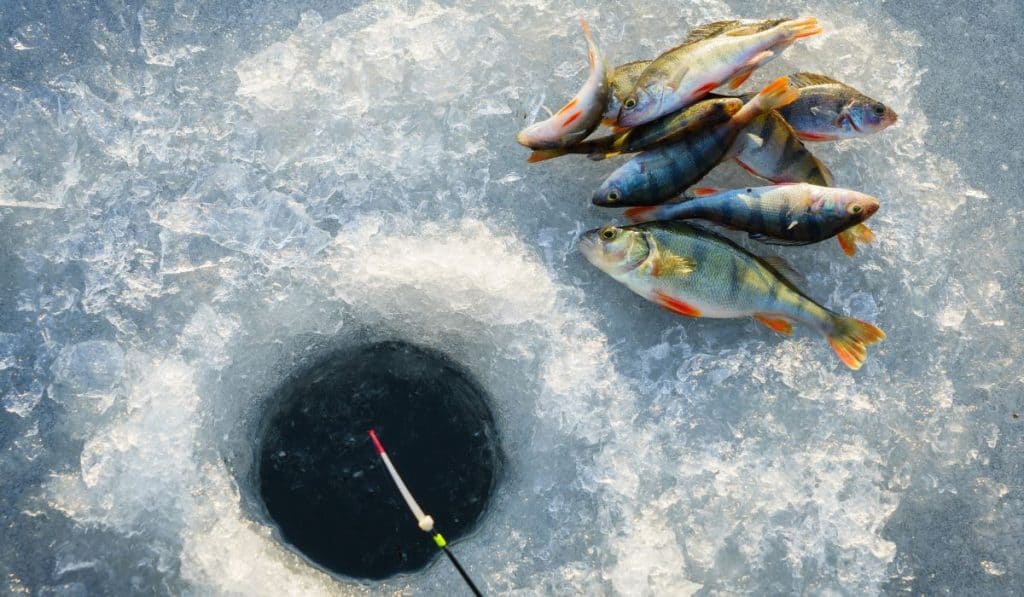
Sounds good. What kind of fish can you catch while ice fishing?
Your catch will depend on where in the world you are seeking to fish. In North America, the following species tend to predominate as freshwater fish that are biting in the winter. In some ways, they are the big bad bullies of the waters which remain active and prey on weaker fish while food is scarce. These are the types of fish that would give you a run for your money in the summer months.
- Walleye or Yellow Pike is a feisty North American staple that is named after its protruding eyes. Walleye is a challenging catch for ice fishing as they are masters of cruising dim and dark waterways and are most active in the darker hours. They remain active and feed straight through the winter months, meaning ice fishing delivers an added opportunity to fish for them.
You will need to be strategic. These fish will be in deeper main lake reaches of the ice, so you need to be willing to venture out, fishing these in the spots you would in a boat with an enticing jigging lure.
- Largemouth bass and Winter bass are definitely a winter eater and contrary to the opinion of many anglers, remain quite active as the temperatures plunge. Not only are they active, but as their usual forage dwindles, you will find they congregate, providing more opportunities to land one.
Early on in an ice fishing season, they tend head further out, but are available in shallower water as the ice season progresses. They will look for light and the brighter and more reflective lure and glow jigs may have success.
- Trout can stay under steam in colder winter months and make for excellent ice fishing. They are known to lurk in shallow water, meaning that you can start drilling closer to the ice edge and work your way out.
Prowl their favorite haunts of mudflats and shallow reed beds where they are known to forage. Beautiful rainbow trout may not have room to leap under ice, but they can still put up a good fight making you feel as though you have earned your supper!
- Pike is a freshwater monster and is an incredibly satisfying catch for the ice fishing angler. Northern Pike is big, heavy, and built for cold water living. They remain active and voracious all year round making it possible to snag a large one through your ice hole.
Pike is usually caught with rod and reel and will gladly chow down on live and frozen bait. You may also be able to entice them with artificial lures. Make sure your tackle is up to the fight as these fish are capable of breaking a line.
- Yellow perch is a favorite of Canadians and it is not uncommon to fill a bucket of these during a day’s fishing. Fishing perch through the ice is all about pinpointing where they are, once you hit the right spot you will be delighted in hauling these through your ice hole in decent quantities. They are definitely a great pick for anglers who are new to the ice fishing hobby and also make a tasty meal!
- Channel catfish are the big beasts of ice fishing, and the cold winter water temperatures may provide your best chance of landing yourself one of these freshwater tigers! The channel cat is North America’s most fished catfish species. These bad boys can grow as large as 20 pounds meaning that ice fishing may give you your opportunity to catch an authentic trophy fish.
Tool up with the best gear for your ice fishing hobby.
Having the right ice fishing equipment and gear is critical to not only catching a fish but also staying warm and safe on the ice. Here is a rundown of your essentials for an ice fishing trip.
Clothing for ice fishing
Warmth, comfort, and freedom of movement are advantageous out on the ice. Layer up items to retain heat as hypothermia can set in quickly:
- Base layers – Natural fiber or synthetic tops and leggings or long johns will keep you centrally warm. Wool is an excellent base layer fabric as it wicks away moisture and remains breathable. This men’s 100% Merino wool long john underwear set by LAPASA is lightweight and warm and makes a great insulating layer.
- Flannel shirts are an ice fishing staple. Thick cotton or wool brushed flannel shirts will keep cozy warm air against you and work as a barrier against the penetrating chill on the ice. Wranglers long sleeve heavy-weight flannel shirt is a classic that should see you through many seasons.
- Sweatshirts are a cheap alternative to a flannel layer or can be doubled up to keep you extra snug.
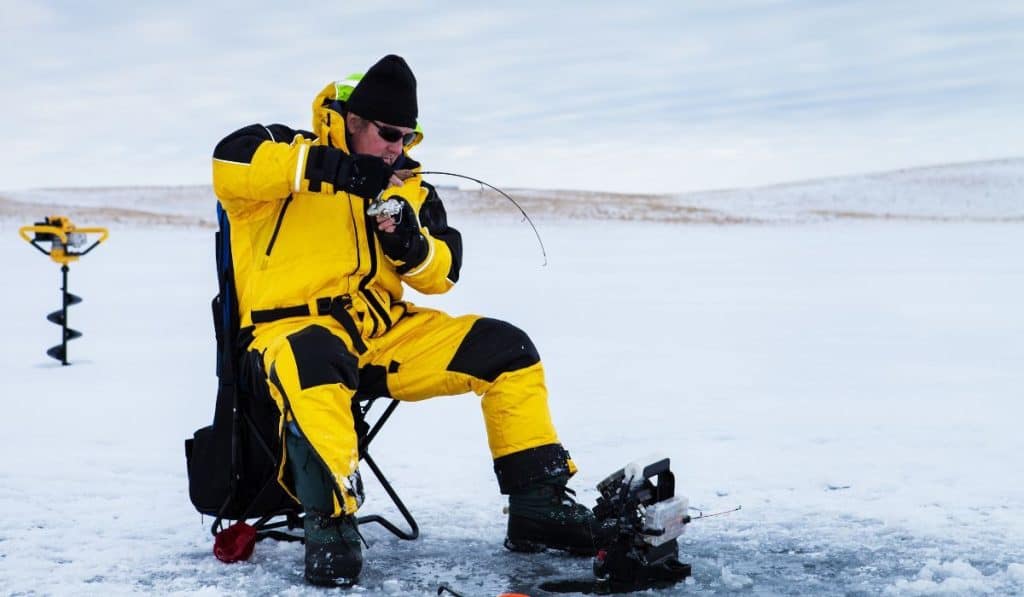
- Bib overalls and jackets are mission-critical outerwear and purchasing a good quality set will keep you protected year after year. A decent ice fishing bib also keeps you dry on the ice and with all that kneeling they need to be seriously hard-wearing too. An ice-fishing bib rather than your old Carhartt overalls will deliver the best performance and insulation of your joints. This smart men’s ice fishing bib and jacket combo made up of the StrikerICE Predator Bib and Hardwater jacket feature cutting edge design and fabric technology that insulate, waterproof, and protect you while you fish. The rugged knee and seat padding are great for getting close to the ice and the insulation is designed to keep you warm without adding excessive bulk, which could become cumbersome.
- Snowsuits are an alternative for ice fishing outerwear, but they may not have been designed specifically for the job.
- Thick wool socks or thermal socks keep your extremities suitably insulated. These battery-operated, heated thermal socks by SVPRO are designed to deliver long-lasting warmth in the coldest of conditions.
- Gloves for ice fishing that are well-insulated and water-resistant will serve you well as you rig your line, hook bait, and try to keep warm. Look for features that will enhance your dexterity such as cut fingers or fingerless designs, a good grip, and materials like neoprene that will wear well. No products found. have been designed with these factors specifically in mind.
- Hats for ice fishing like classic fur-lined trapper hats are perfect for protecting the whole head and right down around your ears. Deep, thick beanies also can do a good job.
- A balaclava is a prudent purchase if you are going to be out on the ice enduring freezing ice winds for a prolonged period. Polar fleece balaclavas are thin and breathable yet very warm.
- Warm waterproof boots for ice fishing are the order of the day. Good traction is essential. This rugged, Thinsulate-lined pair by Norfin Klondaik features retractable ice cleats for added grip on the ice and a thick insole so that your feet stay warm. If you already have duck boots or waterproof winter boots you could add some ice cleats to them to help prevent you from slipping on the ice.
Personal safety items for ice fishing
Amongst others, these safety essentials should be on your person at all times, just in case you need them.
- A spud bar is an unassuming long (4 foot) piece of steel with a pointed end. This ice chisel is used to test and prove the ice you are going to be walking on. Simply strike the ice with the spud bar to check for cracking or chipping. It can also be used as an ice walking stick.
- A Personal Floatation Device (PFD) may seem like overkill to some anglers but remember that beneath that ice there is a whole lot of water, and if you fall in buoyancy will increase your chances of survival and rescue. Simply wear it on your upper body and hopefully, you will be able to forget about it.
- Ice picks are another potential lifesaver if the ice breaks beneath you. These picks can be used to reach for and secure a good grip on more robust ice and will help you to drag yourself up and out of icy water. Again, they are best worn on your person, just in case.
Ice fishing equipment
This list is not exhaustive but should have you equipped with the essentials to have a productive day out on the ice.
- Ice auger: This device looks like a giant corkscrew and is designed for drilling into the ice to create a hole of fixed diameter. They can be manual or power-assisted by a cordless drill. They are the most effective way of getting your ice fishing started. This Eskimo Hand Auger is a popular design with an 8-inch cutting diameter and flat stainless-steel blades that stay sharper for longer.
- Ice saw: This makes a handy alternative to an ice auger and though it is a little more work, it can be used to make square or rectangular holes of the size you require. Black Diamond has produced a smart hinged ice and snow saw that can be attached to a pole for cutting through ice. It features hard-wearing aluminum and steel blades.
- Ice fishing scoop: Ice skimmers look like, and pretty much are long-handled, large-slotted spoons. Use these ice fishing skimmers to keep your ice hole free of obstructions, by removing chunks of ice.
- A sit-N-fish bucket is a handy bait bucket that you can also sit on while you jig your line. You can accessorize these with wrap-around organizers to keep your hooks, lures, pliers, and other gear on hand.
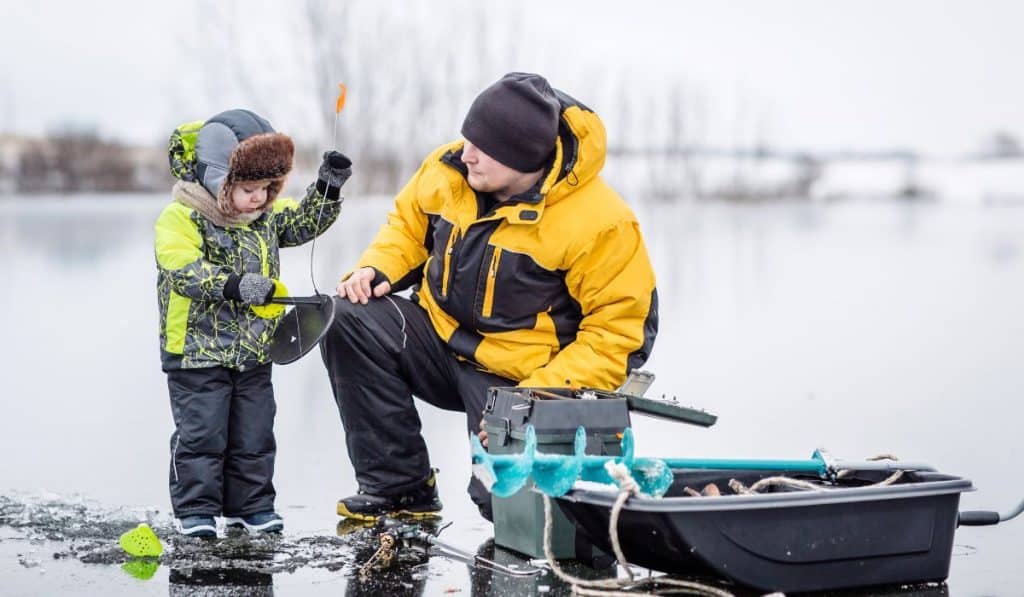
- An ice fishing rod is not an overly demanding, technical, or expensive piece of gear. All you need an ice rod to do, is suspend your lure in your ice hole and jig about, and of course, haul out your catch when you get a bite! Look for a lightweight, flexible rod that is strong and will drop straight.
13 Fishing produces an excellent ice fishing rod and reel combo that is available in right or left-handed design. This high-viz green design has a strong, flexible composite frame with a split-grip Tennessee handle and thin wire line guides.
- An ice fishing spear is attached to a metal or fiberglass rod for spearing fish that come into your view. They are easy to lose, so it is well worth having more than one on hand and attaching a rope to your pole. It can be secured to the pole via the 8mm screw hole.
- A tip-up takes a lot of the effort out of ice fishing, but if you set up multiple ice holes and the biting is good, you may find yourself running here and there. The SF ice-fishing tip-up has strong metal and plastic components, including a ruler that can be used to measure your catch. The springy flag and prompting system is extremely sensitive, meaning you will never miss a bite.
- An ice shelter or shanty can be used to dim the area where you are fishing or as a luxury upgrade for your expedition, with heating and other creature comforts. It is important to remember they will add weight to the ice so they should be as light as possible. Pop-up shelters usually accommodate up to four people and can be quickly assembled and dismantled on the ice. The DANCHEL Outdoor Ice Fishing Tent is made from wind and waterproof polyester, with a Velcro lined closure. Velcro vents also help ventilation, which can be an issue if you are using a heater within the tent.
Tech accessories for 21st-century ice fishing
For many ice fishing anglers, the pastime is no longer primitive and is much more mobile, driven by GPS, sonar, and fish finders, which means you can search for fish rather than waiting it out by your home all day.
Many anglers routinely carry a Garmin Fishfinder with GPS , though for the old-timers and diehards, it takes all the mystery out of the sport!
When is the best time to go ice fishing?
There is a saying amongst seasoned ice anglers: “first ice and last ice produce the best bites!”.
If in your region, ice forms, you probably will enjoy the best fishing in December and February. Also, the time of day does affect your chances of success, with mornings and afternoons bringing the briskest bites.
Temperatures do affect ice fishing with cold fronts slowing down the bite too. As temperatures rise toward freezing the bite will improve.
Snow-covered ice is more insulating for the fish and you will probably find that they are more active where the ice is insulated and shaded by snow. The fish bite more where it is shaded.
Accidents happen, so staying safe while ice fishing is essential!
Understandably, the greatest fear of most ice fishers will be falling through the ice into freezing water, and this is not an exceptionally rare event.
However, ice fishing does carry several other risks that require vigilance for their prevention.
A Mayo Clinic study took a closer look at the accidents that befell ice anglers over 5 years using the National Electronic Injury Surveillance System. Here are some of the most common ice fishing accidents and injuries they found:
- Fishhook injuries, as well as abrasions, cuts, and piercing injuries, were most common.
- Harm from the rudimentary heating systems used by anglers included burns and carbon monoxide inhalation, from fuel heating sources within shelters without adequate ventilation.
- Major trauma included limb loss, concussions, and organ injuries.
- Falling into icy water and hypothermia are also common accidents and can quickly kill. In Russia, the surge in popularity of ice fishing has increased the incidence of ice anglers succumbing to alcohol poisoning or hypothermia after drinking too much Vodka to keep warm.
Safety on the ice is critical as, just like on open water conditions can change throughout the day, and by concentrating on fishing or having a good time, anglers can neglect to keep adequately warm or protected.
Though some anglers do go ice fishing alone, this can be very dangerous as you may not have anyone to help you or raise the alarm if you run into difficulties. Always go ice fishing with at least one other person, at least to take a great picture of you and your catch!
Let folks at home know where you are going and how long you will be gone, and ensure that safety items like a phone, personal floatation device, and ice picks are on hand should the worst happen.
WARNING: Do not walk on ice unless you are assured of its safety
Ice can be tricky and vary greatly in thickness and strength in a single body of water. Also, early and late in the ice fishing season, the ice may not be at its thickest and you may run the risk of falling through. If in doubt, trust your instincts and stay off it. A popular saying amongst ice fishing enthusiasts goes something like this:
“Thick and blue, tried and true. Thin and crispy, way too risky.”
You need to be sure that the ice you walk on is of an adequate thickness to support your weight as well as any equipment or sled you are carrying with you.
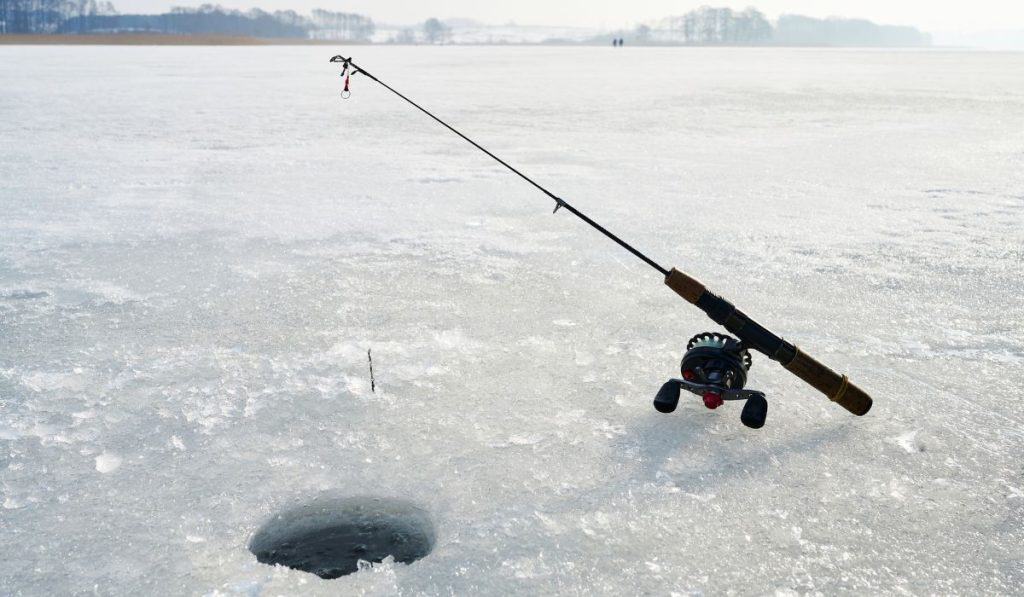
An ice thickness of 4 inches is the minimum thickness needed to support body weight, and over 12 inches or more if you intend to use a snowmobile or ice shanty. A bit of research and local knowledge is worthwhile to learn about the ice where you intend to fish.
Ice is not a homogeneous substance and is affected by factors that include the weather, air temperature, the size and type of water, and the presence of springs or currents.
High winds can break apart the ice and leave anglers drifting towards open water too. These conditions need to be considered as they affect the maintenance of an ice layer that can support you safely.
Visually inspecting the ice, looking for cracks and water as well as logs or rock that can heat up and weaken the ice in their location.
Know the best ice for ice fishing.
As the saying above states, clear blue ice is strongest. You can expect this type of ice fishing ice after three consecutive weeks of temperatures below -8 degrees Celsius (17.6 degrees Fahrenheit). Be wary of snow-covered opaque ice, which may be thick but is far less strong.
Frequently asked questions for ice hobby ice fishing.
Q. What are the best locations for ice fishing?
If the ice is reliable and the fishing is good you will find that people will even travel internationally to enjoy it! Here are some of the best-known ice fishing locations in North America. They all offer perfect conditions, a range of fish to catch, and a long season, making it possible to visit again and again.
In the United States the best ice fishing locations include:
- Leech Lake (MO) is a famous ice fishing location and draws ardent ice fishing enthusiasts to return again and again for a lifetime’s worth of ice fishing. Take your pick of Walleye, perch, and panfish. This Minnesota favorite also offers lakeside accommodations and ice houses out on the lake.
- Lake Erie is one of America’s five Great Lakes and makes the perfect setting for a full season of ice fishing with Walleye and perch being common biters. As it is so vast, it is readily accessed via New York, Michigan, Ohio, and Pennsylvania. In the summer, the lake is affected by Algal bloom, so you need to follow local guidance on the safety of fishing in certain spots.
- Lake Michigan (MI) is another Great Lake that has a huge draw over the winter for ice fishing. Indeed, ice fishermen get into all sorts of scrapes and often require dramatic rescue if ice floes break off and drift. They keep coming back though for more than 150 fish species that can be caught through the ice including Northern Pike and Trout.
In Canada the best ice fishing locations include:
- Lake Winnipeg in Manitoba has achieved worldwide fame for its beautiful natural scenery and the quality of its ice fishing. Be prepared to get atop a snowmobile with plentiful supplies to head out onto the lake for a great excursion that is a family draw. Walleye and Burbot are popular catches.
- Lake of the Woods in Ontario/Manitoba is another location that is prized for its ice fishing. They claim to offer the “ultimate” experience in ice fishing with giant Northerns, Perch, and Walleye. They offer numerous heated fish houses which are continually moved by guides to the most advantageous spots. Lake of the Woods ice fishing season runs until April.
Q. Do I need a license to ice fish?
In most parts of North America, you are going to need a fishing license before you hit the water. Fishing licenses help the authorities keep track of fish stocks and ensure that lakes are not overfished.
The cost of your fishing license also funds vital environmental protection and stewardship which makes these beautiful, frozen lakes great for everyone.
A valid fishing license is not usually specifically issued for ice fishing. Purchase an annual license and you should be good to go.
Q. Where can I learn more about ice fishing?
Here are some great organizations that provide more information on ice fishing:
- The United States Ice Fishing Association is a repository of great information and advice about ice fishing. They also convene events and tournaments across the northern and eastern states, including Colorado, Wisconsin, and Wyoming. You can also join this organization to participate in competitions.
- The National Ice Fishing Association provides resources for tackle, augers, electronics, and other ice fishing accessories, as well as forums and a directory for North American ice fishermen.
The official ice fishing Reddit has a thriving online community of Redditors who love everything ice fishing. This is a great page for asking questions too.
Also, check out Ivo Coia of Thundermist Lures on YouTube. This Ontario native is a real encyclopedia of all that is exciting about ice fishing.
Lake Erie Ice Fishing
Rounding up
We hope that you have found this article a great head-start for making ice fishing a well-loved hobby. The only way you are going to know if this is the hobby for you is to wrap up warm, fill your flask and get out there and have a go.
In North America, anytime between late November and March is well within the ice fishing season, meaning that you have a whole winter of winters to rig and jig your lines in the deep freeze!

